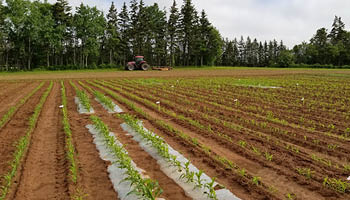The Maritimes aren’t known for being a corn-growing powerhouse. However, this does not make the grain any less important to Maritime farmers as more corn fields begin to crop up on the east coast.
“In years past, we heard from local grain elevator operators and corn sellers that low test weights for corn could be a concern for Maritime producers. Test weight is a measure of the density of a grain, like a kernel of corn. Higher test weight is important for farmers because it often means healthier and better-quality corn. That’s a big factor for storing and processing, and it has economic impacts for farmers,” explains Dan MacEachern, Agriculture and Agri-Food Canada (AAFC) research biologist on Prince Edward Island.
To help Maritimes corn producers, Dan began researching corn test weight at the AAFC Harrington Research Farm near Charlottetown in 2018, in collaboration with the Atlantic Grains Council (AGC). Their five-year project finished in 2023 and provides very practical and effective tips for increasing corn test weights in the Maritimes.
Amazing findings for Maritime corn producers
There are many elements that affect corn test weight, including how soil nutrients are managed, the type of corn variety grown, the number of corn plants grown together, weather, and more. Initially, Dan and his team studied the effects of different types of fertilizers on early-, mid-, and late- season maturing corn varieties that are adapted to Maritime growing conditions.
“We discovered that ammonium sulphate fertilizer was the only nitrogen source that resulted in higher corn yield and test weight. Early and mid-maturing hybrid corn varieties also had higher test weights compared to late-maturing varieties.”
- Dan MacEachern, research biologist, Agriculture and Agri-Food Canada
Sulphur is one of several essential nutrients for plants to grow, and in the case of corn grown in the Maritimes, the one nutrient that farmers were missing to obtain high quality, good yielding crops. In addition to sulphur content, the type of corn variety also affected the yield according to Dan’s research. The mid-season maturing variety performed the best for yield, followed by early, then late-maturing varieties. Dan explains those results could be due to early and late maturing corn being more at risk to frost which may limit test weight and yield.
Once Dan, his team, and AGC partners found that higher sulphur content fertilizer had a positive effect on both corn test weight and yield, they decided to research the ideal amount that should be applied to ensure the fertilizer is being used most efficiently, while still improving test weight and yield.
“For test weight and yield, the team found that the sweet spot for the sulphur fertilizer rate was in the low to mid-range, around 45 kg per hectare. It’s the lower fertilizer amount that the crop used most efficiently and was most cost-effective. That’s welcome news for farmers and the environment.”
The sulphur scoop with poop
While small amounts of sulphur added to corn fields is beneficial to test weight and yield, too much could lead to losing excess to groundwater sources. To reduce the possibility of this, Dan suggests that farmers always test their soils before adding any amendments to ensure they use only as much as the soil and crop needs.
As for sources of sulphur, the answer could be right under farmers’ noses.
“Manure is my top choice as a sulphur source for corn. It provides a natural source of sulphur among other important organic nutrients that help crops grow. Where manure cannot be easily sourced, ammonium sulphate is a solid runner-up.”
- Dan MacEachern, research biologist, Agriculture and Agri-Food Canada
Key discoveries and benefits
- Test weight measures the density of a grain, like a kernel of corn. Higher test weight in corn crops is important for farmers because it often means healthier and better-quality corn. Test weight is also a big factor for storage and processing, and it has economic impacts for farmers.
- To help Maritime corn producers, AAFC research biologist Dan MacEachern began researching corn test weight at the AAFC Harrington Research Farm near Charlottetown in 2018, in collaboration with the Atlantic Grains Council.
- Dan and his team discovered that ammonium sulphate fertilizer was the only nitrogen source that resulted in higher corn yield and test weight, while the early and mid-maturing hybrid corn varieties also had higher test weights compared to late-maturing varieties. The mid-season maturing variety performed the best for yield, following by early, then late-maturing varieties.
- While small amounts of sulphur added to corn fields is beneficial to test weight and yield, too much could lead to losing excess to groundwater sources. To reduce the possibility of this, Dan suggests that farmers always test their soils before adding any amendments to ensure they use only as much as the soil and crop needs.
- Manure is Dan’s top choice as a sulphur source for corn. It provides sulphur naturally among other important organic nutrients that help crops grow. Where manure can’t be easily sourced, ammonium sulphate is a solid runner-up.
Photo gallery

